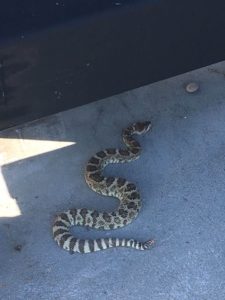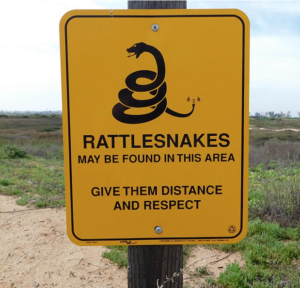As the weather becomes warmer, the California Department of Fish and Wildlife and poison control officials are warning Californians to be aware of rattlesnake encounters. In fact, just recently a rattlesnake was spotted at Cal OES headquarters.

Rattlesnake spotted at Cal OES Headquarters in Mather, California
Rattlesnakes do not always make a rattling sound, so someone can be standing next to a rattlesnake and not even know it. Children need to be carefully supervised outside, especially in wooded and desert areas where snakes tend to live.
A rattlesnake bite can cause painful swelling, bleeding and bruising, but are rarely fatal, according to the California Poison Control System. Those most at risk for potentially deadly impacts are children and pets. Victims of rattlesnake bites should seek immediate medical attention at an emergency room.
Overall, rattlesnakes are an important part of the ecosystem as they eat rodents and are eaten by other predators. The chances of being bitten are small compared to the risk of other environmental injuries and should not deter you from venturing outdoors.
Here are some tips to avoid a rattlesnake bite:
- Be alert. After a cold or cool night, they will attempt to raise their body temperature by basking in the sun. To prevent overheating during hot days of spring and summer, they will become more active at dawn, dusk or night.
- Wear sturdy boots and loose-fitting long pants. Never go barefoot or wear sandals when walking through brushy, wild areas.
- When hiking, stick to well-used trails. Avoid tall grass, weeds and heavy underbrush where snakes may hide during the day.
- Do not step or put your hands where you cannot see. Step ON logs and rocks, never over them, and be especially careful when climbing rocks or gathering firewood. Check out stumps or logs before sitting down, and shake out sleeping bags before use.
- Never grab “sticks” or “branches” while swimming in lakes and rivers. Rattlesnakes can swim.
- Be careful when stepping over doorsteps as well. Snakes like to crawl along the edge of buildings where they are protected on one side.
- Never hike alone. Always have someone with you who can assist in an emergency.
- Do not handle a freshly killed snake, as it can still inject venom.
- Teach children early to respect snakes and to leave them alone.
- Leash your dog when hiking in snake country. Dogs are at increased risk of being bitten due to holding their nose to the ground while investigating the outdoors.
- Carry a cell phone and make sure that family or friends know where you are going and when you will be checking in.
In the event of a rattlesnake bite:
- Stay calm but act quickly.
- Call 9-1-1.

- Transport the victim to the nearest medical facility.
- Remove watches, rings, etc., which may constrict swelling.
- DON’T apply a tourniquet.
- DON’T pack the bite area in ice.
- DON’T cut the wound with a knife or razor.
- DON’T use your mouth to suck out the venom.
- DON’T let the victim drink alcohol.
Contact the California Poison Control System:
Call Poison Control at 1-800-222-1222 for questions about poison encounters. Trained pharmacists, nurses and other health providers are available to help 24 hours a day, seven days a week. The service is free and confidential and interpreters are available.
Additional Resources:
California Department of Fish and Wildlife (CDFW) – Snakes
California Poison Control System
Wildlife Habitat Relationships – Life History and Range


This is so amazing info about snakes. I like to share its to my friends.
Please keep up and don’t stop to sharing of such a good information.
Thanks